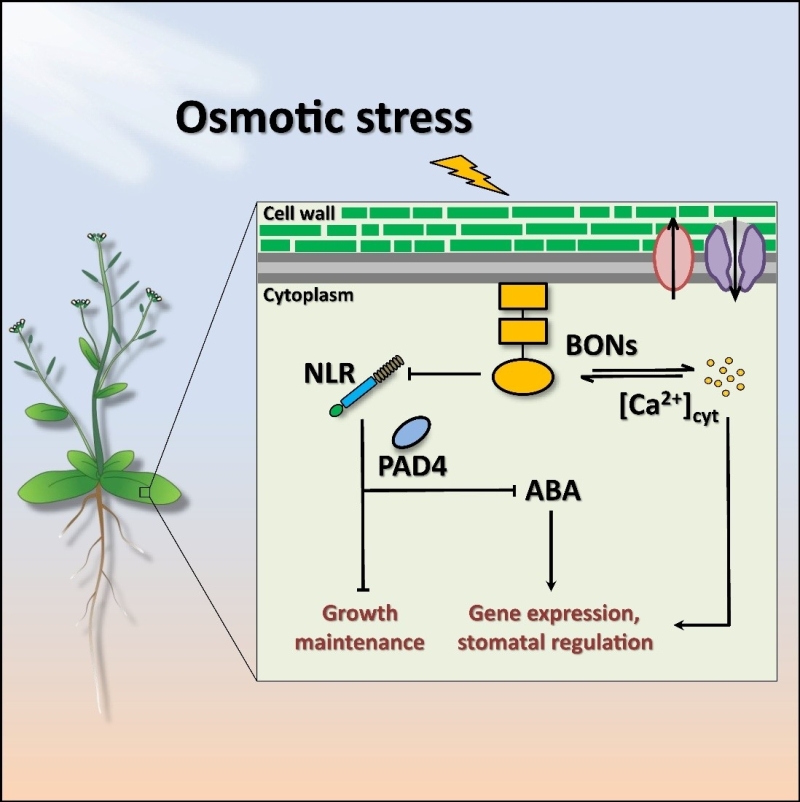How to transduce osmotic stress signal in plants?
Scientists at the Shanghai Center for Plant Stress Biology, Center for Excellence in Molecular Plant Sciences of the Chinese Academy of Sciences, have identified the BON proteins as critical components of upstream osmotic stress signaling.
Climate change makes environmental stresses, including drought, salinity and cold stresses, occur more frequently and intensively, which often leads to massive yield loss and food insecurity. Hyperosmotic stress caused by drought and salinity is the most significant environmental stress in agricultural production. As sessile organisms, plants have evolved complicated sensing and signaling mechanisms to survive and thrive in ever-changing environments. These signaling networks consist of three major parts, including signal perception and upstream signaling, accumulation and signaling of plant hormone ABA, and coordination of downstream stress responses. Up to now, the ABA-dependent osmotic stress signaling has been well established. However, the sensing and upstream signaling of hyperosmotic stress remain unclear in plants.
Osmotic stress in plants triggers multiple responses including transient elevation of cytosolic Ca2+ (within seconds); activation of protein kinase (within minutes); regulation of Ca2+-dependent response; accumulation of ABA, stomatal closure, and gene expression changes (within hours); as well as long-term responses such as growth regulation, leaf senescence, and dormancy. Prior studies have reported that Ca2+ channels and uniporters, including OSCA1, KEAs, and cMUC, participate in regulating Ca2+ signals induced by hyperosmotic stress, although none of them controls global osmotic stress responses. These implicated that there may exist osmosensor(s) mediating Ca2+-dependent and -independent pathways through distinct manners.
Kong Chen, Shujing Shun and colleagues in Yang Zhao’s and Jian-Kang Zhu’s labs have now identified the OSMO/BON proteins as critical regulators that control both early Ca2+ signals and multiple later osmotic stress responses. Their findings, entitiled “BONZAI Proteins Control Global Osmotic Stress Responses in Plants” is now published on October 8, 2020, in Current Biology. Scientists from other institutes also contribute to this work, including Drs. Jinhui Gao (Northwest A&F University), Jian Hua (Cornell University), and Ray A. Bressan (Purdue University).
In order to identify upstream regulators of osmotic stress signaling, scientists conducted a forward genetic screen based on the luminescent Ca2+ sensor aequorin. The luminescence emission of aequorin peaks at 465 nm, which falls within the absorption spectrum of chlorophyll b. To reduce the interference from chlorophylls in young seedlings, scientist introduced the aequorin reporter system into the sig6 mutant that has albino cotyledons. This smart approach allowed the authors to detect osmo1 mutant impaired in shoot-based hyperosmotic stress Ca2+ signaling.
OSMO1 encodes a Ca2+-dependent phospholipid binding protein BON1, which is localized to the cell membrane. BON1 is mediated by N-terminal myristylation, and contains two Ca2+-dependent phospholipid-binding C2 domains, and a C-terminal Ca2+-binding VWA domain. Although BON proteins are required for multiple osmotic stress responses including Ca2+ signaling, accumulation of the stress hormone ABA, reprogramming of gene expression, and altering growth, they are not required for the activation of SnRK2 protein kinases, indicating that osmosensors mediate Ca2+ signaling and ABA accumulation through a BON-dependent manner, while mediate SnRK2 activation in a BON-independent manner.
Further studies found that R protein-mediated signals were activated under prolonged osmotic stress and antagonized osmotic stress responses such as ABA accumulation and gene expression. Previous reports have shown that BON proteins are negative regulators of R protein-mediated immune response. Genetic evidence in this study suggests that BON proteins control ABA accumulation, gene expression reprogramming and plant growth by repressing the R proteins signaling.
This study identified the BON proteins as critical regulators of both osmotic stress-triggered Ca2+ signal and an array of osmotic stress responses and revealed a global repression of osmotic stress responses by signaling from the NLR plant immune receptor proteins. This points to an antagonism between abiotic and biotic responses where BON proteins likely have a balancing role.
Funding: This study is supported by the Strategic Priority Research Program of the Chinese Academy of Sciences (grant No. XDB27040107), the National Natural Science Foundation China (NSFC grant 31970293), and the Shanghai Pujiang Program (18PJ1410900).
